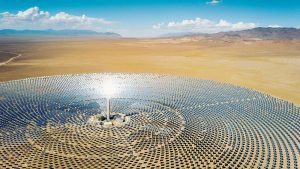 (Note: The links in bold font are required reading for this exercise. Those in regular font are optional but may be useful, depending on your own background.)
(Note: The links in bold font are required reading for this exercise. Those in regular font are optional but may be useful, depending on your own background.)
The surface of the earth absorbs some of the solar energy that falls on it and reflects the rest of it back into space. Clouds, snow, dark plowed fields, cities, and bodies of water all absorb and reflect different proportions of the solar energy that falls on them. That proportion is measured as albedo. The UCAR Center for Science Education explains that:
“Understanding how much energy from the Sun is reflected back out to space and how much is absorbed becoming heat is important for understanding climate. . . If Earth’s climate is colder and there is more snow and ice on the planet, albedo increases, more sunlight is reflected out to space, and the climate gets even cooler. But, when warming causes snow and ice to melt, darker colored surfaces are exposed, albedo decreases, less solar energy is reflected out to space, and the planet warms even more. This is known as the ice-albedo feedback.”
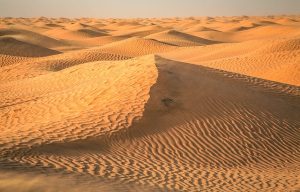 A few solar panels on a house don’t impact the earth’s albedo very much. But big solar farms dramatically change the earth’s albedo in specific locations, and can cause large-scale changes of temperature, rainfall, and vegetation that create a chain reaction of further changes in albedo, escalating the problem. As a result, you can read here (please do so) how paving parts of the Sahara desert in Tunisia and Morocco with solar panels for “green energy” will likely change global climate in dramatic new ways (Lu and Smith 2021):
A few solar panels on a house don’t impact the earth’s albedo very much. But big solar farms dramatically change the earth’s albedo in specific locations, and can cause large-scale changes of temperature, rainfall, and vegetation that create a chain reaction of further changes in albedo, escalating the problem. As a result, you can read here (please do so) how paving parts of the Sahara desert in Tunisia and Morocco with solar panels for “green energy” will likely change global climate in dramatic new ways (Lu and Smith 2021):
“While the black surfaces of solar panels absorb most of the sunlight that reaches them, only a fraction (around 15%) of that incoming energy gets converted to electricity. The rest is returned to the environment as heat. The panels are usually much darker than the ground they cover, so a vast expanse of solar cells will absorb a lot of additional energy and emit it as heat, affecting the climate.” (Read Lu and Smith’s article in this PDF if the link above stops working.)
Please note that this quoted passage refers not just to changes from altered albedo, but to what happens when energy changes from one form to another — from incoming solar radiation to electricity and waste heat. Lu and Smith are saying the efficiency of that conversion is about 15% in this case. That means 85% of the solar energy caught by the solar panels becomes waste heat that raises temperatures around the solar farm location. (By comparison, efficiency of energy conversion is about 30% in wind turbines.) As you read the details in their paper, linked just above the quoted passage, you need to remember that similar desert-paving solar farms are being developed elsewhere, in locations all over the world.
Please read a brief summary and abstract of another paper by Li et al. (2018), this one published in the prestigeous journal Science, which acknowledges that the solar farms proposed for the Sahara will probably cause the same changes Lu and Smith predicted. These changes include warmer local temperatures and more local rainfall that causes more vegetation to grow, which, in turn, further increases rainfall. (PDF of summary here if link stops working.) They also agreed that most of this impact would result from changes in the earth’s albedo at that location, though some would result from the waste heat released during the energy transfer. But the authors whose paper was published in Science say these changes are acceptable given the circumstances, and are probably something that would not happen elsewhere, even though models run by Kirk-Davidoff et al (2018) show the same kinds of temperature, rainfall, and vegetation changes from both large-scale solar and also wind farms. The last paragraph of Li et al’s paper (which is not visible at the linked page unless you can access the journal through your institution) states that large-scale wind as well as solar farms in the Sahara:
“. . . could also trigger more precipitation, largely because of a previously overlooked vegetation feedback. This highlights that, in addition to avoiding anthropogenic greenhouse gas emissions from fossil fuels and the resulting warming, wind and solar energy could have other unexpected beneficial climate impacts when deployed at a large scale in the Sahara, where conditions are especially favorable for these impacts.”
Questions for your process:
Lu and Smith say increased rainfall in the Sahara is a deleterious climate impact and they detail their reasons for saying so. They published their paper in 2021, after Li et al published the one that appeared in Science (in 2018 — that’s the paper I quoted last.) Why do you think Li et al saw increased rainfall and vegetation in the Saraha as as beneficial, rather than deleterious, climate change?
How does RFTO affect the concept that anthropogenic climate change can be beneficial?
Why do you think more attention isn’t being paid to warnings like those of Lu and Smith? Is there some reason that heeding their warnings would create problems for people?
Li et al. (the Science paper) said large-scale wind farms will also cause higher temperatures and more rainfall in the places they’re installed. The problems are not associated only with solar farms because they derive from physical Laws of Thermodynamics. How might it be possible to get the issue of solar and wind farm climate risks on the table in a responsible way? Or do you think the risks of wind and solar farms simply have to be accepted under the circumstances?
One of the reasons electricity production and distribution need to be increased from current levels, rather than kept at or near current levels, is that ground transportation presently relying on fossil fuels is being changed over to electric power. You just read and thought about issues related to electric cars. How do those thoughts influence the way you see Western culture’s focus on using wind and solar power to produce electricity while reducing CO2 emissions?
Is there a better way to reframe the energy problems the world is facing, as an alternative to “we have to reduce carbon emissions to save the world”?
If you look at the fairly rough diagram I made of the prairie ecosystem back in our exploration of burning the tallgrass prairie of the Flint Hills, you’ll see the sun is part of it. Think for a few moments about the relationship the sun has to some of the other things on that diagram, from people to insects to the grasses themselves. Think about the difference between seasons such as summer and winter, which vary largely because of changes in the sun’s relative position to the land and how long it’s in the sky. What might be the impact of large solar farms in prairie areas such as the Flint Hills?
People often see desert as “wasteland” where nothing lives. Please read the short reprinted passage below, “Lived Expressions of the Dark Forest/Fiery Desert Myth in Desert Ecosystems,” from a Tapestry Institution Occasional Paper I published elsewhere on this website with co-author Jo Belasco (at the page linked in the passage title). The reference numbers listed in the “reprint” here are listed as citations at the bottom of this page for your convenience.
“Lived Expressions of the Dark Forest, Fiery Desert Myth in Desert Ecosystems.
“The deserts of what is now the southwestern United States are home to military bombing and gunnery ranges, war games theaters, armament and radioactive waste dumps, and test and development facilities for both conventional and nuclear weapons. These facilities and the controlled airspace above them occupy almost half the land area of the state of Nevada alone, and extend into the deserts of Utah, California, Arizona, and New Mexico (36). Deserts were selected for these purposes at a time when landscapes of many kinds across the U.S. were still largely uninhabited because desert land “. . . wasn’t really much good for anything but gunnery practice – you could bomb it into oblivion and never notice the difference.” (37; italics added by V. Kuletz)
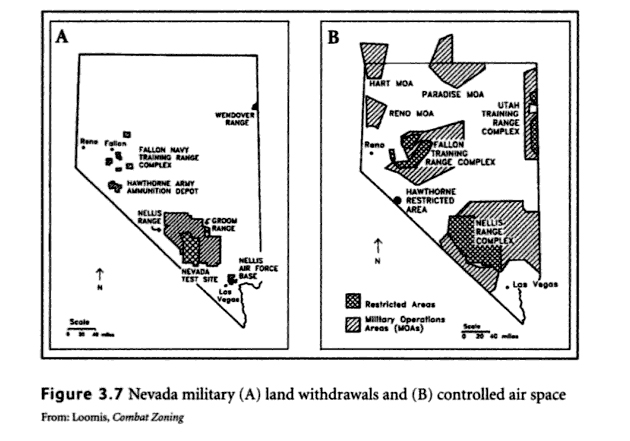
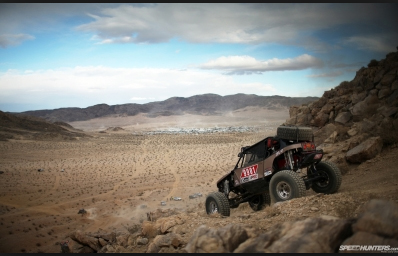
“Many people of Western culture see the desert as an inhospitable no-man’s land with no intrinsic merit. They speed through Nevada with their car’s air conditioners on high, hoping not to break down in the heat. Or they outfit their cars for desert travel and intentionally journey off road to heroically test themselves in the same arid landscape. Both sets of behaviors are lived expressions of the Dark Forest, Fiery Desert Myth.
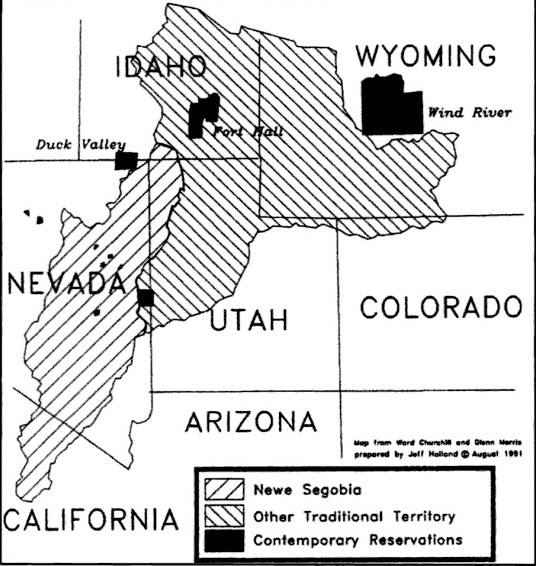
It is fairly easy to see this view of the desert is mythic and cultural rather than actual. Before the deserts of Nevada were turned to military use, they were the ancestral homelands of the Shoshone and Paiute. These people do not see the desert or relate to it through the Dark Forest, Fiery Desert Myth. Barbara Durham, Death Valley Tribal Historic Preservation Officer of the Timbisha Shoshone Tribe writes (38):
“’Our desert lands need protection because they are lands that have significant importance to us, the Timbisha Shoshone Tribe, neighboring tribes and the desert communities. Areas such as the Avawatz Mountains, the Panamint Valley, the Coso Range area, Silurian Valley and the Kingston Range all matter to us; their presence is valued for their history, landscape, story telling and connection with our ancestors who lived here and enjoyed them as much as we do today. The plants, animals and people of these areas have survived through countless hostilities and threat of extinction but we always persevered because it is our duty to protect our lands, our homes, our way of life and ties to our aboriginal territories.’
“Of course, the difference between Shoshone and Paiute views of desert land and the U.S. military view informed by Dark Forest, Fiery Desert Myth creates serious cross-cultural conflict (39).
“Yet unconscious Mythic views of reality are not hard-wired into individual behavior or social policy. Edward Abbey wrote of the beauty in desert landscapes with reverence, as did John Muir. Even the federal government’s National Park website for Death Valley uses appreciative language to describe the desert environment. Notice the caveat of the highlighted passage, though: that the desert’s beauty and abundance exist ‘Despite the harshness and severity of the environment’ — as opposed to because of the uniqueness of an environment with low humidity and lots of sunlight (40; bold emphasis added by authors).
“’Death Valley: The name is forbidding and gloomy. . . Despite the harshness and severity of the environment, more than 1000 kinds of plants live within the park. Those on the valley floor have adapted to a desert life by a variety of means. Some have roots that go down 10 times the height of a person. Some plants have a root system that lies just below the surface but extends out in all directions. Others have leaves and stems that allow very little evaporation and loss of life giving water. . . Death Valley’s great range of elevations and habitats support a variety of wildlife species, including 51 species of native mammals, 307 species of birds, 36 species of reptiles, three species of amphibians, and five species and one subspecies of native fishes. Small mammals are more numerous than large mammals, such as desert bighorn, coyote, bobcat, mountain lion, and mule deer. Mule deer are present in the pinyon/juniper associations of the Grapevine, Cottonwood, and Panamint Mountains.’
“Comparing views of the desert that made it an ‘obvious’ choice for testing bombs to views expressed in the Death Valley National Park text show why it’s been a contentious issue for scholars to determine how Western culture really sees nature, and why. Yet notice the Dark Forest, Fiery Desert Myth is still present even in the appreciative Park text, hidden in the apparently simple prepositional phrase ‘despite the harshness and severity of the environment.’ The Dark Forest, Fiery Desert Myth is often submerged beneath the surface of positive Western views of nature this way, like an alligator with only its eyes visible above the water line.”
How does the typical Western cultural perception of desert impact development of solar farms? Do you think it might also impact the mining at Thacker Pass you just read about?
Lu and Smith point to the “downwind” consequences of changing the climate of desert areas with solar farm emplacements. As you think about the prairie diagram, and about the earth’s system of moving weather systems (warm and cold fronts, winds, rainstorms), the role of sunlight in heating land and water surfaces, and the complex ways that nature operates, how does this impact your perception of solar farms? Does RFTO figure into this?
Why do you think I titled this page “Mining the Sun” instead of “Mining Sunlight”?
Now please visit Mining the Wind. But before you go, remember that these pages absolutely do NOT argue for continued use of carbon-based energy sources. Instead, they point to one of the biggest problems facing contemporary people today: unnecessarily dualistic “either/or” energy solutions that focus on what type of energy to use without including additional considerations such as how much energy to use. Either/or duality forces people into making choices that trade one destructive and non-sustainable “solution” for another because the real underlying problem — in this case, that we use unsustainable amounts of energy — is never seen or addressed.
—–
References for the piece of my own and Belasco’s paper cited above:
36. Valerie Kuletz. 1998. The Tainted Desert: Environmental Ruin in the American West. 368 pages. Psychology Press. (Routledge)
37. David Loomis. 1993. Combat Zoning: Military Land-Use Planning In Nevada. University of Nevada Press. 168 pages. Cited in Kuletz, Op Cit., page 66.
38. “Campaign for the California Desert” website. http://californiadesert.org/supporters/quotes/ Accessed June 26, 2015.
39. Valerie Kuletz, Op cit., pages 63-64.
40. Quote is from “Death Valley National Park.” National Park Service website, webpages “Nature” at http://www.nps.gov/deva/learn/nature/index.htm and “Animals” at http://www.nps.gov/deva/learn/nature/animals.htm. Accessed June 24, 2015. See also Edward Abbey. 1977. Desert Solitaire: A Season in the Wilderness. Mass Market Paperbacks, 303 pages.
